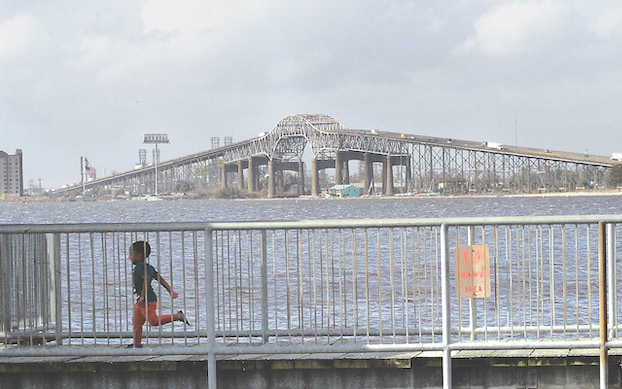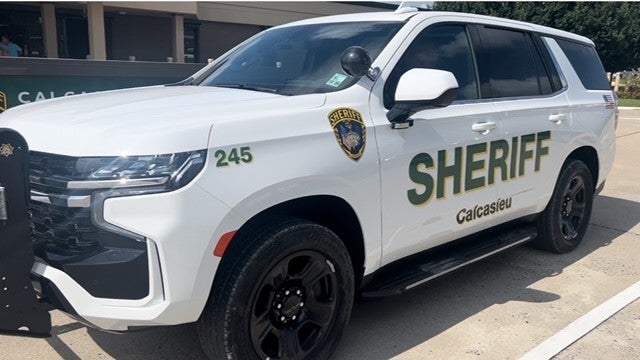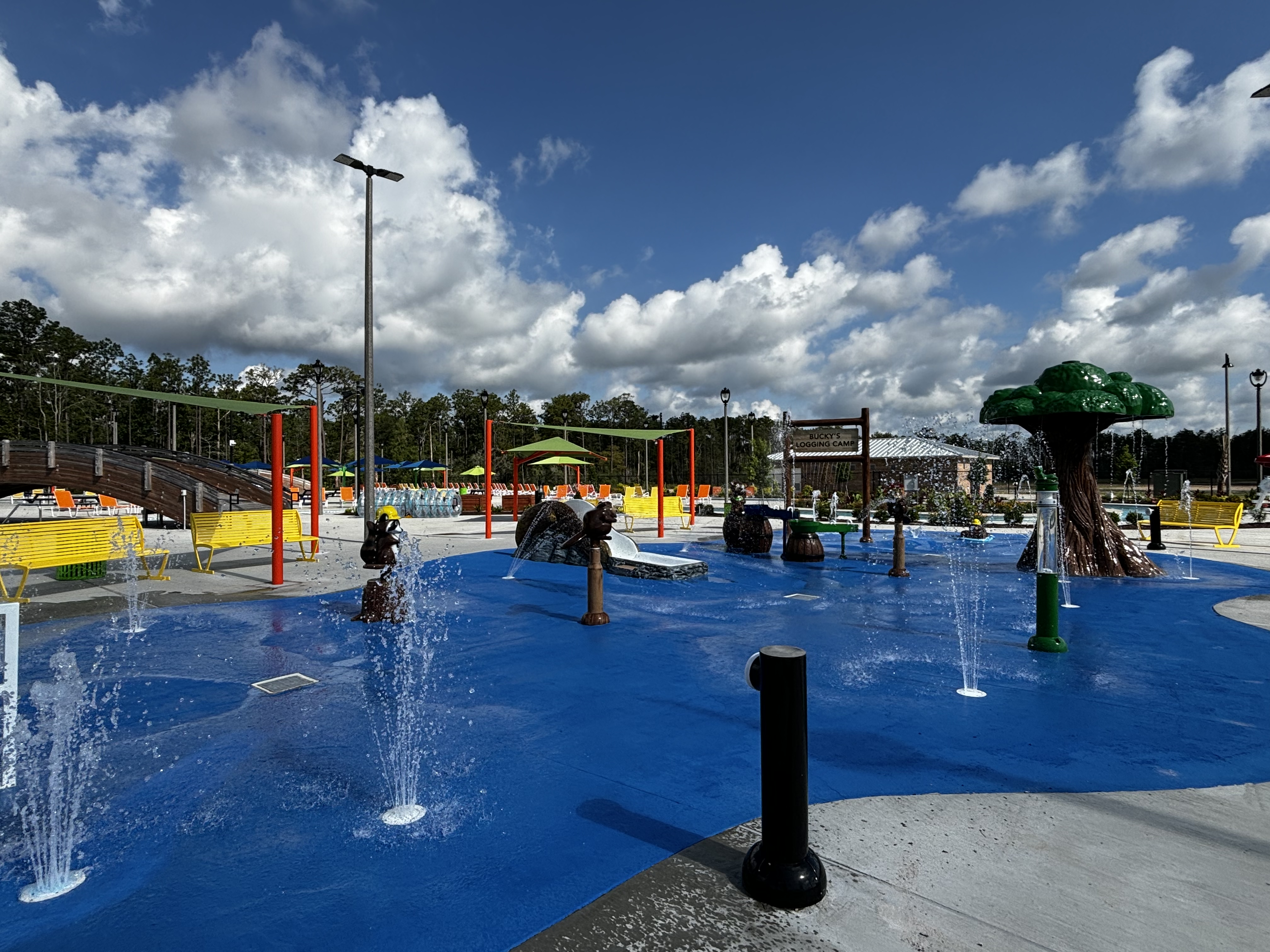$150M in additional funds for new 1-10 Calcasieu River Bridge
Published 5:36 pm Thursday, December 29, 2022

- A boy runs along a lakefront walkway Thursday in front of the 70-year-old I-10 Calcasieu River Bridge. It was announced Thursday that the U.S. Dept. of Transportation is awarding $150M in Mega Grant funding for a new bridge to be built. (Donna Price / American Press)
The Interstate 10-Calcasieu River Bridge replacement project has received additional funding through a $150 million Mega Grant that has been awarded by the U.S. Department of Transportation.
This competitive grant will be distributed as part of the DOT’s Mega Program, or National Infrastructure Project Assistance Program, and is part of the FY22 Multimodal Progract Discretionary Grant Opportunity. This is a new program that came into fruition after the passing of the Bipartisan Infrastructure Law of 2021.
The focus of the program is to financially support “large, complex projects that are difficult to fund by other means and likely to generate national or regional economic, mobility or safety benefits.”
In its totality, the Mega Grant Program has $5 billion in funding available until FY26, or until expended, according to the DOT.
Louisiana Department of Transportation and Development Secretary Shawn Wilson said based on the rules of engagement, the bridge replacement project qualified for up to $600 million in Mega Grant funding.
He said receiving this funding is a testament to LADOTD’s consistent efforts to use nationally recognized best practices.
“We are way more competitive, and are swinging above our weight class in terms of the bridges and projects that we are competing against nationally.”
Nine projects were funded through the Mega Grant Program with Louisiana receiving the third-largest grant nationwide. Wilson said this large sum of funding is setting a prosperous precedent for the state, as the $150 million grant is the largest grant the LADOTD has ever been awarded.
“I am very excited to see the total investment that we have received from a discretionary perspective since 2016.”
The efforts to receive funding for the project have been collaborative.
“I would like to thank the Biden administration, U.S. DOT Secretary Pete Buttigieg, Sen. Bill Cassidy and Congressman Troy Carter for their help in passing the Bipartisan Infrastructure Bill and their continued advocacy to improve infrastructure across Louisiana,” said Gov. John Bel Edwards.
Legislators throughout the state have shown their support for the grant.
“Since coming to Congress, my office has worked with our local, state and federal partners to build consensus and advance the I-10 Calcasieu River Bridge project,” said U.S. Congressman Clay Higgins. “Replacement efforts are moving forward, and this Mega Grant provides the state with significant federal funding. We are building a new bridge at I-10 in Lake Charles.”
On May 31, 2022, Higgins — along with Cassidy, Carter and U.S. Congressmen Mike Johnson and Julia Letlow — submitted a letter of support of the grant to Buttigieg.
The letter cited the economic impact of the I-10 Calcasieu River Bridge project, stating it “is a critical gateway point for industrial construction projects such as Sasol, Cheniere, Sabine Pass LNG, Driftwood LNG, Magnolia LNG, Cameron LNG and many others.”
Edwards described the Calcasieu River Bridge as “a key bridge on one of our main priority routes.”
Southwest Louisiana’s rank as a “global leader in energy exports” served as a primary justification for the grant. The letter written to Buttigieg stated that “with this strategic investment in Southwest Louisiana’s infrastructure needs, we can unlock its full potential, benefiting the entire nation.”
“It will greatly benefit the state and region by providing lasting economic benefits, allowing for an increase in capacity and a vastly improved structure,” Edwards said.
The cost of the I-10 Bridge project currently sits at $1.5 billion, and counting. Wilson said that is just for a portion of the project.
Currently, the LADOTD has secured $550 million in funding in cash. Additionally, the project will receive $40 million from the Vehicle Sales Tax per year.
Wilson explained that the key to getting the project off the ground is to secure funding as soon as possible.
“The reality is we need to get started sooner than later, and the way you do that is with private financing.”
In the first quarter of FY23, the final public-private partnership proposals will be requested. Those proposals will then undergo local jurisdiction review and public proposal hearings in the second quarter of FY2023.
He confirmed that several hundred millions of dollars has been secured in private activity bonds. “That is a very affordable and very inexpensive option for financing large transportation projects.”
There is no way around instituting a toll on the proposed bridge, he said.
“We would have loved to have done this without the tolls, but the reality is this project is financially not feasible any other way other than leveraging private financing,” he said. “We could wait and hope and keep our fingers crossed that money comes, but in the meantime we have not, and will not, be taking steps to build the bridge.
“This allows us to, hopefully, move forward with actually building something in such that you actually have a bridge that you are using, as opposed to having a bridge that is unacceptable.”
By making the proposed I-10 bridge a toll bridge, the LADOTD will finally be able to make headway in this decades-long project, he said.
“This allows us to move forward. This bridge is at the end of its useful life. We have worked on this for over two decades. It’s most important for us to get started than to get started in the most perfect way.”
At the LADOTD and Federal Highway Administration open house public hearing on Dec. 13, information stating that the toll rate will be $2.88 was distributed.
Wilson stated that the price of the toll has not been finalized. Current estimations of the toll cost are based on multiple toll studies that have been conducted by the LADOTD.
The final product and price of the tolls will be determined after the bridge’s cost proposals are drafted.
Wilson said since costs are not finalized, it is possible that they will lower in the future. “There are still opportunities to lower the cost and/or the length of tolls with additional dollars within the structure of our project over the course of this.”
Wilson said the tolls will be appropriately priced based on the actual cost to build and maintain the bridge.
“You can build bridges of a number of different types and approaches and elements, and the public-private partner has the opportunity to present what they believe to be the most efficient and affordable bridge structure,” he said. “Based on that, they will then have a financial model that will establish a toll rate for vehicles that are locally driven and owned within the region, vehicles traveling abroad, as well as different sized trucks.”
A clear timeline will be established after bids are received in the 2nd quarter of next year. Prior to this, however, there is still significant work to be done, including rerouting, maintaining traffic, design, right-a-way and utility relocation.
Wilson stressed that receiving this grant is a triumphant development. “While this doesn’t necessarily get us to construction tomorrow, this is a huge step forward in being able to have a contract signed and delivered.”
“This is what bridge building looks like,” said Wilson. “This is progress.”





